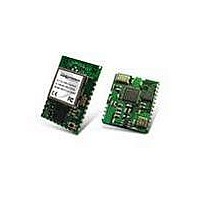WI.232EUR-R Radiotronix, WI.232EUR-R Datasheet - Page 8

WI.232EUR-R
Manufacturer Part Number
WI.232EUR-R
Description
EMBEDDED RADIO MODULE
Manufacturer
Radiotronix
Datasheet
1.RK-WI.232EUR-R.pdf
(29 pages)
Specifications of WI.232EUR-R
Frequency Rf
869.885MHz
Module Interface
Serial, UART
Tool / Board Applications
Wireless Connectivity-ZigBee, RF, Infrared, USB
Sensitivity
-106dBm
Data Rate Max
76.8Kbps
Supply Current
65mA
Maximum Frequency
869.885 MHz
Supply Voltage (max)
3.6 V
Supply Voltage (min)
2.7 V
Maximum Operating Temperature
+ 85 C
Minimum Frequency
868.225 MHz
Minimum Operating Temperature
- 40 C
Product
RF Modules
Frequency Range
868.225MHz To 869.885MHz
Supply Voltage Range
2.7V To 3.6V
Rohs Compliant
Yes
Lead Free Status / RoHS Status
Lead free / RoHS Compliant
Lead Free Status / RoHS Status
Lead free / RoHS Compliant
Modules can operate in groups. Each module can be assigned a 7-bit group ID, which is used to
logically link it to other modules on the same channel. All modules on a channel will interoperate,
regardless of their respective group Ids. In other words, the CSMA mechanism will prevent
collisions of modules on the same channel but belonging to different groups.
Modules can also operate in two network modes: Master/Slave and Peer-to-Peer. These modes
define a set of communication rules that identifies which modules can talk to any given module.
In Master/Slave mode, masters can talk to slaves and other masters, slaves can talk to masters,
but slaves cannot talk to other slaves. This mode is sometimes required for applications that are
replacing legacy RS-485 networks. In peer-to-peer mode, any module can hear any other
module. In both modes, group integrity is enforced.
When a module transmits a packet, all other modules on the same channel will receive the
packet, check the packet for errors, and determine whether the received group ID matches the
local group ID. If the packet is error free and the group Ids match, the module will decrypt the
data if necessary, and send the error free data to its host UART for processing. The modules
only implement the ISO reference network stack up to the MAC layer, so they are transparent to
link layer addressing schemes. Therefore, the modules can work with any link-layer and higher
protocols in existing today.
Certain features of the module are controlled through programmable registers. Registers are
access by bringing CMD low. When CMD is low, all data transfers from the host UART are
considered to be register access commands. When CMD is high, all data transfers from the host
UART are considered to be raw data that needs to be transparently transmitted across the
wireless link. The module maintains two copies of each register: one in flash and one in RAM.
On reset, the module loads the RAM registers from the values in the flash registers. The module
is operated out of the RAM registers. Applications that need to change parameters of the module
often would simply modify the RAM register. By putting default settings in the flash registers, the
module will always come up in a preconfigured state, which is useful for applications that do not
have external microcontrollers, such as RS-232 adapters.
The UART interface is capable of operating in full duplex at baud rates from 2.4 to 115.2 kbps.
The module has 10 power modes: 4 wideband modes, 4 narrowband modes, standby, and sleep.
In wideband mode, the module’s channel bandwidth is set to 600kHz. In this mode, the module
can operate on 2 channels and support a maximum RF data rate of 76.8kbit/second. The
receiver sensitivity at the max data rate is –102dBm typical, yielding a maximum link budget of
115dB. This mode is an excellent alternative to frequency hopping spread spectrum. It requires
no synchronization, allowing it to operate in a duty-cycle mode for extended battery life.
In narrowband mode, the module’s channel bandwidth is set to 200kHz. In this mode, the module
can operate on 6 channels and supports a maximum data rate of 9600 baud. The receiver
sensitivity at the maximum data rate is –104 typical, yielding a link budget of 117dB.
The module can be placed into sleep mode through the command mode. In sleep mode, the RF
section is completely shutdown, and the protocol processor is in an idle state. Once the module
has been placed in the sleep mode, it can be awakened by either cycling power, which will loose
all volatile settings, or by sending a power-up sequence through the serial port. The power up
sequence is 0x00, 0xFF, 0xFF, 0xFF sent back-to-back at the data rate for which the module is
configured.
Note: When in sleep mode, the module will not be able to receive data from other modules. Any
data sent to the module while it is in sleep mode will be lost.
Wi.232EUR User’s Manual
© 2003-2007 Radiotronix Inc.
7














